Understanding SAT Evidence-Based Reading and Writing Section
Author
Hartwell
Date Published

The creators of the new SAT have decided that Reading and Writing now go hand in hand, much like peanut butter and jelly. Instead of having these as two separate sections, the College Board now includes both Reading and Writing together in a single section.
This guide will explain what you need to know about the combined Reading and Writing section of the SAT, and how the new format can change the way you prepare for the test. Let’s start by understanding what the new section includes.
What Is the SAT Reading and Writing Section?
This is an important question! Before answering, let’s discuss the major changes that happened when the SAT became fully digital in 2024.
The new digital SAT now has just two main sections: Math and Reading and Writing. Each section is divided into two parts, called modules, so there are four modules in total on the test.
The Reading and Writing section consists of two modules, each lasting 32 minutes and containing 27 questions. Together, there are 54 questions to complete in 64 minutes. The highest possible score for this section is 800. With Math also worth 800 points, the SAT’s total score remains out of 1600.
On much older versions of the SAT, before 2016, Reading and Writing were scored separately, with 800 points available for each. This added up to a total score of 2400. Back then, the language sections (called Critical Reading and Writing) made up two-thirds of the total points, while Math counted for only one third. This setup favored students who were stronger in English.
When big changes were made to the SAT in 2016, Reading and Writing were scored together as “Evidence-Based Reading and Writing” (EBRW), for a total of 800 points. This meant that half the total score was from the verbal sections, and the other half from Math, producing a perfect score of 1600.
This has not changed with the new digital SAT; the two main sections, Reading/Writing and Math, are still equal in weight. The main difference today is that Reading and Writing are no longer considered separate sections. They are now combined into one part: the SAT Reading and Writing section.
Another important change is in how reading passages are presented. On the old SAT, from 2016 to 2023, Reading and Writing each had just a few long passages, with several questions connected to each one. On the new digital SAT, the passages are much shorter, usually only 25 to 150 words each, and each passage is followed by just one question (sometimes two passages are paired for one question).
How Should You Prepare for SAT Reading and Writing?
If you want to boost your skills and achieve a high score on the SAT Reading and Writing section, it’s best to begin by practicing with actual SAT practice tests. These tests show you the kinds of questions you’ll see and help you get used to the test’s format.
The digital SAT, as you might expect, is taken entirely on a device—such as a computer, tablet, or Chromebook. Students use special software called Bluebook, made by the College Board, to take the test.
Read on to learn more about the new SAT Reading and Writing section. At the end of this article, you’ll find five useful tips to help you succeed on test day. First, let’s look at how your Reading and Writing section score is calculated and how it affects your overall SAT result.
Where Does Your SAT Reading and Writing Score Come From?
As mentioned before, the Reading and Writing section is scored from 200 to 800, just like the Math section on the SAT. On test day, you’ll start with the SAT Reading and Writing section. The first part you’ll face is Module 1, which lasts 32 minutes and contains 27 questions. After this, you’ll move on to Module 2, which has the same length and number of questions, but is different in one important way: this second module adjusts to your performance on Module 1.
This means that every student will get a second module that is tailored to how well they did on the first module. If you answer most questions correctly in Module 1, Module 2 will be more challenging. If you struggle with Module 1, Module 2 will give you easier questions. According to the College Board, you don’t need to get every question right to earn a good score if your second module is harder, since more difficult questions are worth more points.
While we know that harder questions count for more, the exact values are not shared by the College Board. Therefore, it’s hard to predict your total score just by counting your correct answers. The good news is that you don’t have to worry about doing any calculations yourself! Since the test is digital, it does the scoring for you—including for official SAT practice tests. These practice tests follow the real test’s format, so you can experience adaptive modules ahead of your actual test day. After finishing a practice test, you’ll immediately see your results, including how many questions you got right and wrong.
Taking an adaptive test might seem a bit intimidating if you’ve never done it before, but it actually brings several benefits: adaptive testing makes the exam shorter, matches the test to your skill level, and measures your abilities more accurately. This is one of the main reasons why the SAT changed to a digital format.
Currently, there are six full-length digital practice tests available in Bluebook, the software used for the SAT. In addition, the College Board offers six official paper practice tests. If you have already tried one of these paper tests, you may notice that the way of scoring is different.
However, the paper practice tests are not exactly the same as the digital SAT because they do not use adaptive testing. They have more questions than the digital version—for Reading and Writing, the paper test has 66 questions, compared to 54 on the digital SAT, and for Math, the paper test has 54 questions. That means the paper version contains 22 more questions than the computer version. The College Board suggests that only students who have been approved to take the SAT on paper for special reasons should use the paper tests, but they are also good for extra practice after you finish all the digital practice tests on Bluebook.
To score your paper practice test, first count the number of correct answers in each Reading and Writing module—give yourself one point for every right answer and zero for any wrong or skipped answer. Then, add the scores from Module 1 and Module 2 together to get your total “raw score” for the Reading and Writing section. The next step will show you how to combine your module scores and calculate your raw score for this section.

After you’ve calculated your raw score for the Reading and Writing section, you’ll need to convert that raw score to a scaled score using a chart provided with official SAT practice tests. This chart gives you an “upper” and a “lower” value for each raw score.
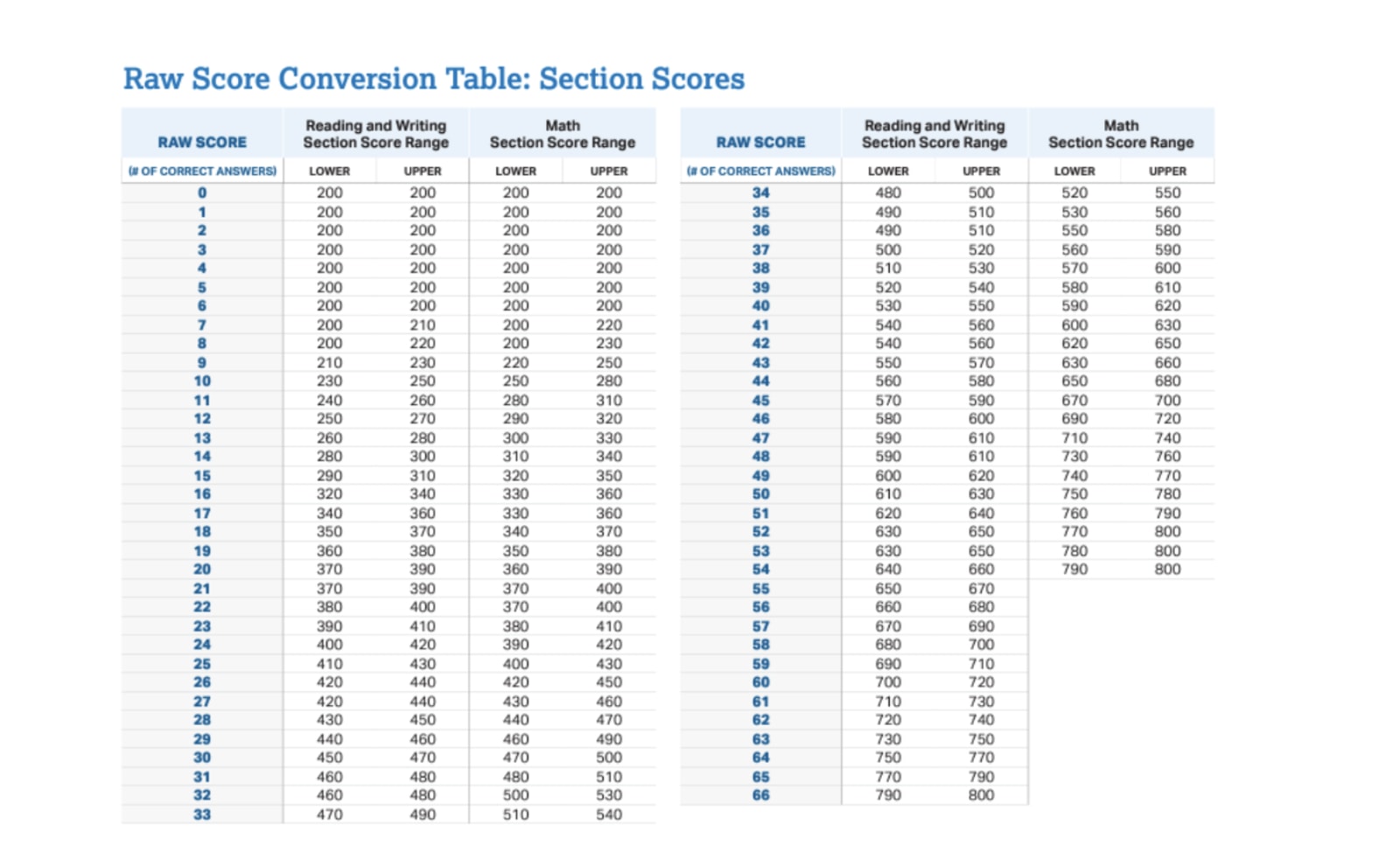
Let’s look at an example:

Having both an upper and lower score might seem confusing, but you don’t need to worry too much about the details. The reason there are two scores for the same raw score is that the paper practice test does not use the adaptive model found on the digital SAT. According to the College Board, this paper scoring system is a simplified, and therefore slightly less accurate, version of the real digital test’s scoring.
SAT Reading and Writing: An Overview
The SAT always starts with the Reading and Writing section. This part of the test measures your reading and language abilities to see how ready you are for college and future careers. You will see lots of short reading passages and questions that test your skills in understanding, analyzing, and improving language.
SAT Reading and Writing Format

All the questions in this section are multiple choice, and each one gives you four answer choices: A, B, C, or D. Every question will be paired with a short reading passage, usually between 25 and 150 words. Sometimes, you may see a pair of passages. These passages come from different subjects, including world literature, history, social studies, the humanities, and science. Some passages will have graphics, like charts or tables.
SAT Reading and Writing Content
Although the section is now shorter (with just 54 total questions), it tests the same skills as before, when there were separate Reading and Writing sections known as Evidence-Based Reading and Writing (EBRW). In this new format, you’ll be asked to:
- Read and understand information and ideas in different kinds of texts.
- Analyze how each passage is structured and written.
- Revise passages to improve how ideas are expressed.
- Edit for grammar, punctuation, and standard English conventions.
You’ll have 27 questions in each module and each module lasts 32 minutes, so you’ll answer 54 questions in 64 minutes.
Types of SAT Reading and Writing Questions
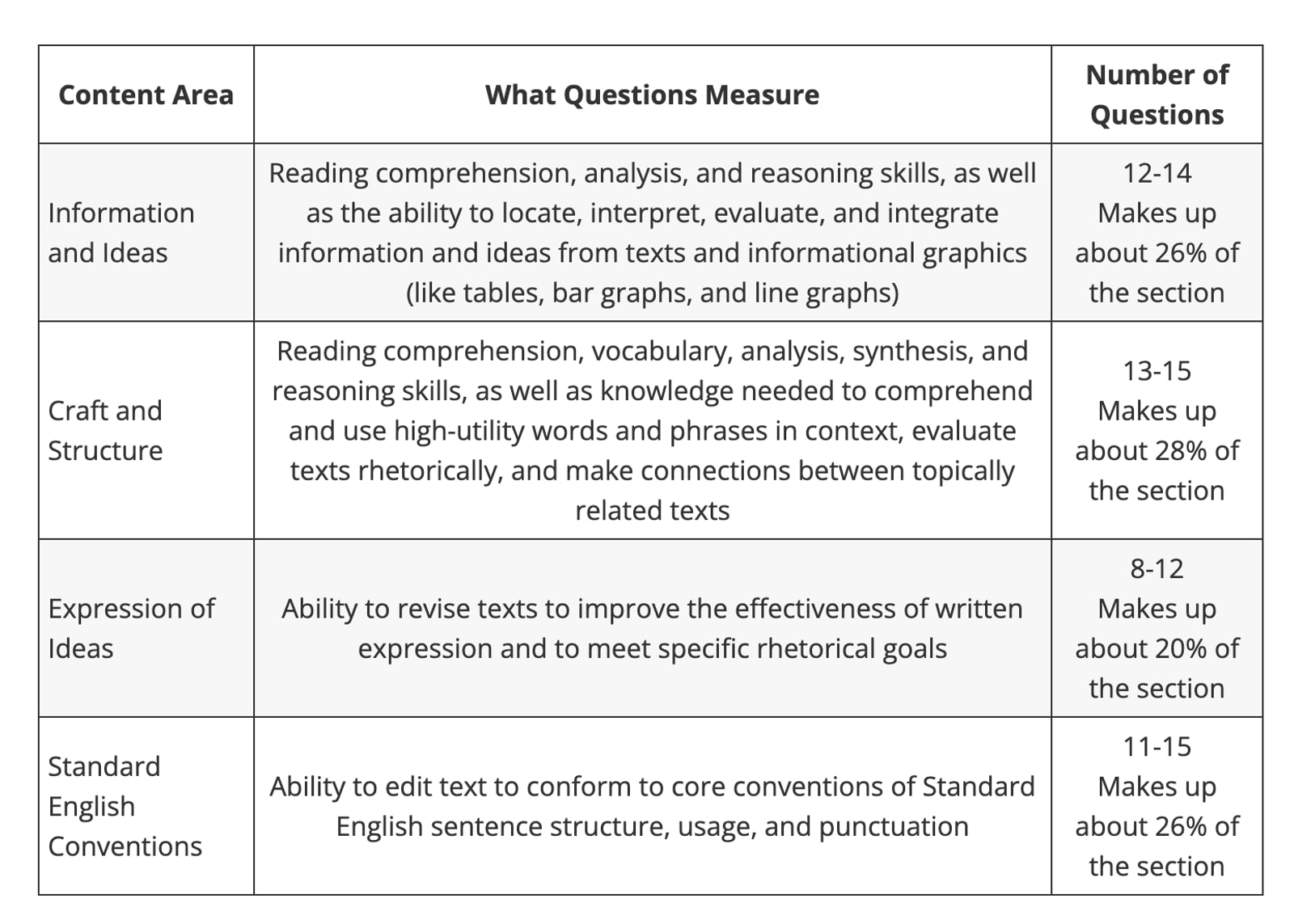
Questions on this section can be grouped into four main types of content. For the “Reading” part, you’ll need to answer questions about the main idea, key details, words in context, inferences, the function of sentences, author’s techniques, evidence support, and interpreting data. These questions test both your understanding of the big picture and your attention to details.
About 74% of the questions in this section focus on “Information and Ideas,” “Craft and Structure,” and “Expression of Ideas.” These questions may ask you about how to develop and support ideas, use vocabulary correctly, and organize information in the best way.
The remaining 26% of the questions test “Standard English Conventions,” such as grammar, sentence structure, usage, and punctuation. These focus on details like where to put commas or how to correct a sentence.
For a detailed look at each question type, including samples, check out a full SAT Reading guide. Now let’s talk about the “Writing” side of this section. Here, you’ll act like an editor—finding and fixing grammar and punctuation mistakes, improving word choices, and making better sentence organization. You may need to replace words, fix a sentence, rearrange information, or add and remove details to make the passage clearer.
As you can see, the new single Reading and Writing section covers a wide range of language skills. Does combining them into one section change how you should prepare? Let’s find out in the next part!
Preparing for SAT Reading and Writing: 5 Key Tips
It’s important to remember that the SAT Reading and Writing section includes questions that test both reading and writing skills. Even though the new digital SAT combines these two areas into a single section, the types of skills tested remain very similar to those in the separate sections of the past. Instead of thinking of the test as two different parts, focus on the four main types of questions: Information and Ideas, Craft and Structure, Expression of Ideas, and Standard English Conventions.
You’ll need to read many short passages and answer questions about things like word meaning in context, text structure, purpose, connections across texts, central ideas and details, using evidence (from both text and charts), making inferences, understanding boundaries, form, structure, rhetorical strategies, and transitions.
The good news is that the kinds of questions on the digital SAT Reading and Writing section are almost the same as those on the old paper SAT (2016-2023). The biggest change is that everything is now in one section, and the passages are shorter—each passage or passage pair comes with just one question. Because the content is so similar, you can still use many old SAT prep materials to help you prepare, as long as you understand the updated format.
Here are five essential tips to help you get ready for all types of questions you’ll see on SAT Reading and Writing:
1.Focus on Command of Evidence
On both the old and new SAT, you’ll be asked about Command of Evidence. These questions require you to find and use evidence from the passage to support your answers. Now, they are part of the “Information and Ideas” category, but the skill is the same—you must use information from the text to answer correctly.
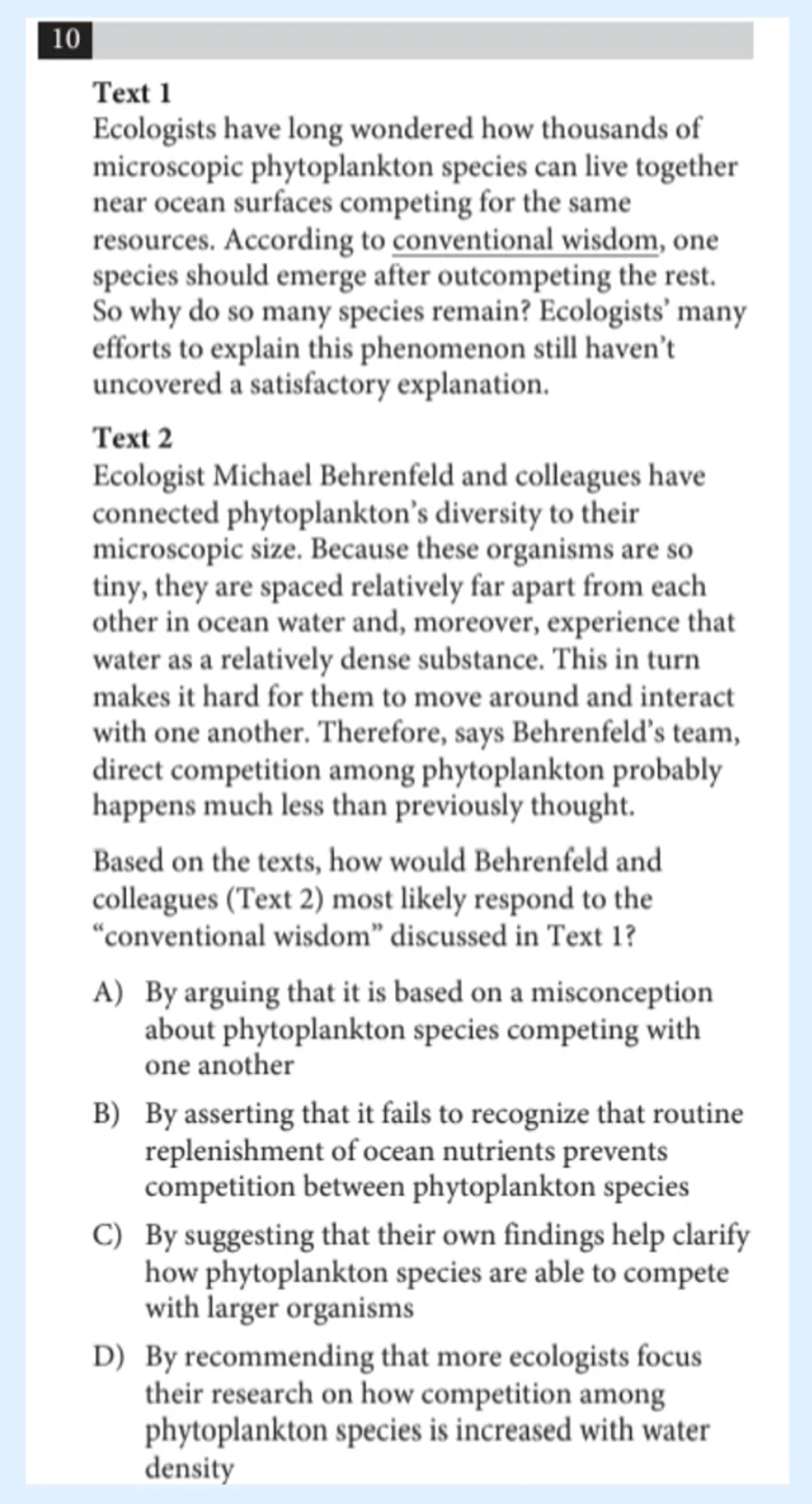
Practice carefully reading each passage and pay close attention to supporting evidence. The better you get at this skill, the higher your reading and writing score will likely be.

2.Study Words in Context
There are about 13–15 questions on the SAT Reading and Writing section that focus on understanding how words are used in context. Every question in this section is based on a passage, so you’ll need to choose the word that best fits the meaning intended in the passage.
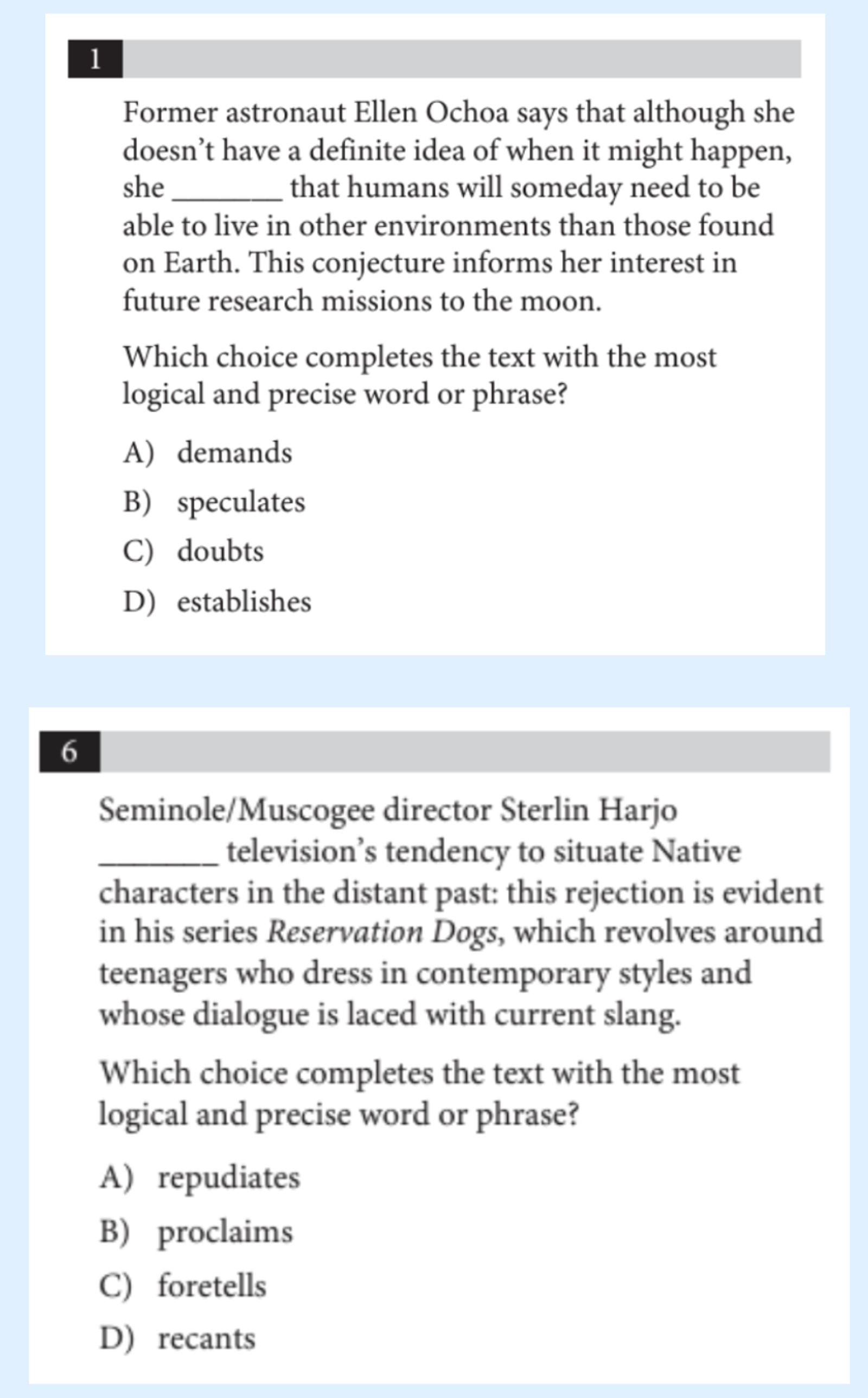
To do well with these questions, practice figuring out the meaning of a word based on how it is used. Often, you will see common words that have more than one meaning. Pay special attention to these types of words during your SAT prep.
3.Practice Data Interpretation Questions
SAT Reading and Writing also requires you to understand data shown in charts, tables, and graphs—often connected to a reading passage. You’ll be asked to interpret what the data shows and sometimes to connect information from the graphic to the ideas in the text.
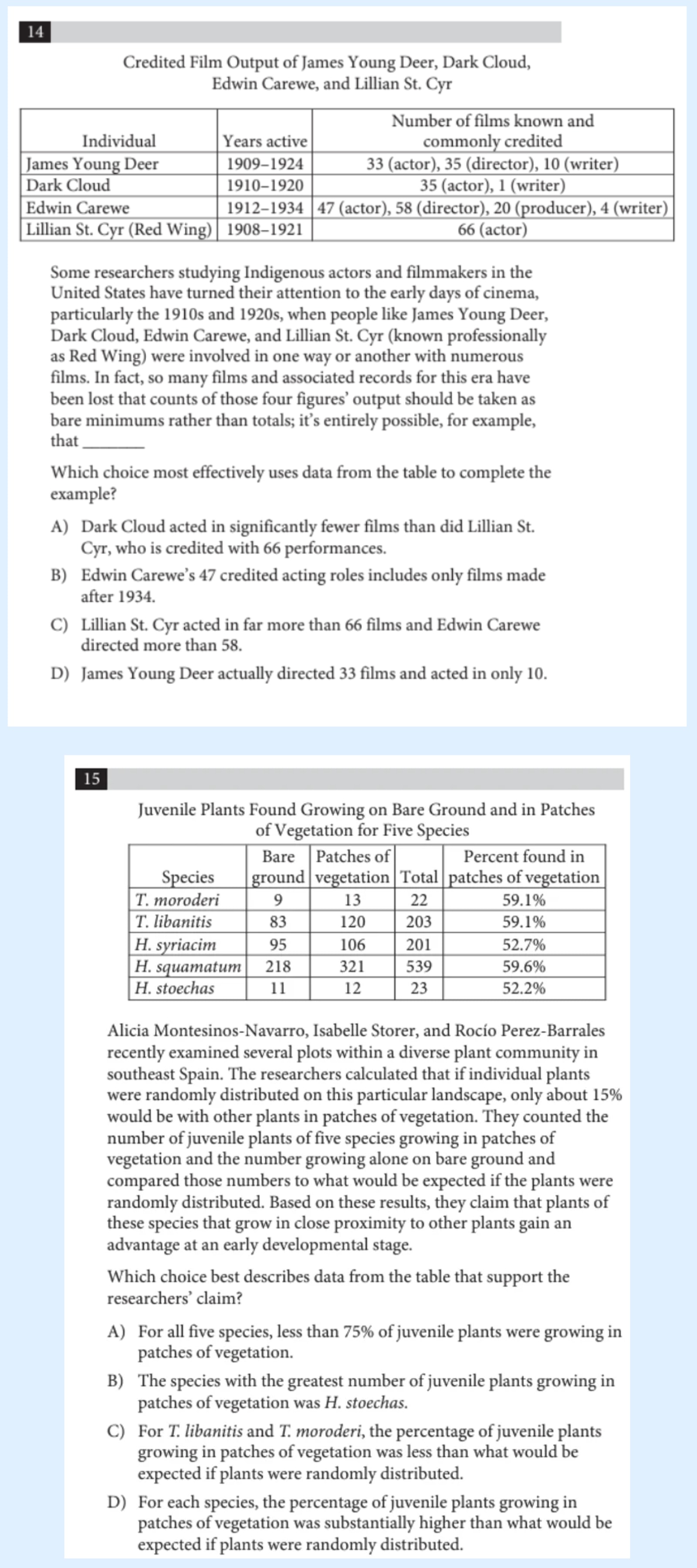
To improve your skills, regularly practice with data interpretation questions. Work on describing trends, comparing values, and connecting data to what you have read. SAT prep books and official practice tests usually have plenty of these questions. You can also try science data questions from ACT practice materials for extra practice.
4.Read and Write Widely
The first three tips focused on specific question types and skills you need for the SAT Reading and Writing section. But on a broader level, this part of the SAT measures your overall understanding of the English language. One of the best ways to improve your abilities is to read widely and write often.
Since the SAT Reading and Writing section uses short passages from many genres—especially nonfiction and argument-based texts—it’s helpful to practice reading not just stories, but also articles, history documents, and science pieces. While it’s important to learn how to analyze arguments or word choice, simply making a habit of reading and writing regularly will help you improve. Over time, this practice will strengthen your reading comprehension and make you a better writer.
5.Be Strategic About Your Scores
One last tip: remember that your SAT score is made up of half Math and half Reading and Writing. The Reading and Writing section is now a single section with a score between 200 and 800. You don’t have to worry about combining two separate verbal section scores anymore—your Reading and Writing score is clear and direct.
Despite the new format, the skills you need are the same as before. Focus on the types of questions you find most difficult, and keep practicing to improve your weaker areas. By being mindful of your strengths and weaknesses, you can study more efficiently and raise your overall score.
There are other useful strategies for each of the four main content areas—Information and Ideas, Craft and Structure, Expression of Ideas, and Standard English Conventions—but if you remember these five tips, you’ll be well on your way to doing your best on the SAT Reading and Writing section.
SAT Reading and Writing: Final Thoughts
The most important thing to remember is that on the new digital SAT, Reading and Writing is a single section, scored from 200 to 800. This section has two modules, each lasting 32 minutes with 27 questions, making a total of 54 questions in 64 minutes. Every question is based on a short passage or a pair of passages and tests your skills in:
- Information and Ideas
- Craft and Structure
- Expression of Ideas
- Standard English Conventions
You will answer questions about reading comprehension, analysis, synthesizing information, editing grammar mistakes, improving organization, fixing punctuation, and more. Many questions focus on your command of evidence, understanding words in context, ability to interpret data, and your overall English language skills.
Finally, always remember that the Reading and Writing section is one-half of your total SAT score. The Math section is the other half, so make sure to review and prepare for both sections carefully.
Related Posts
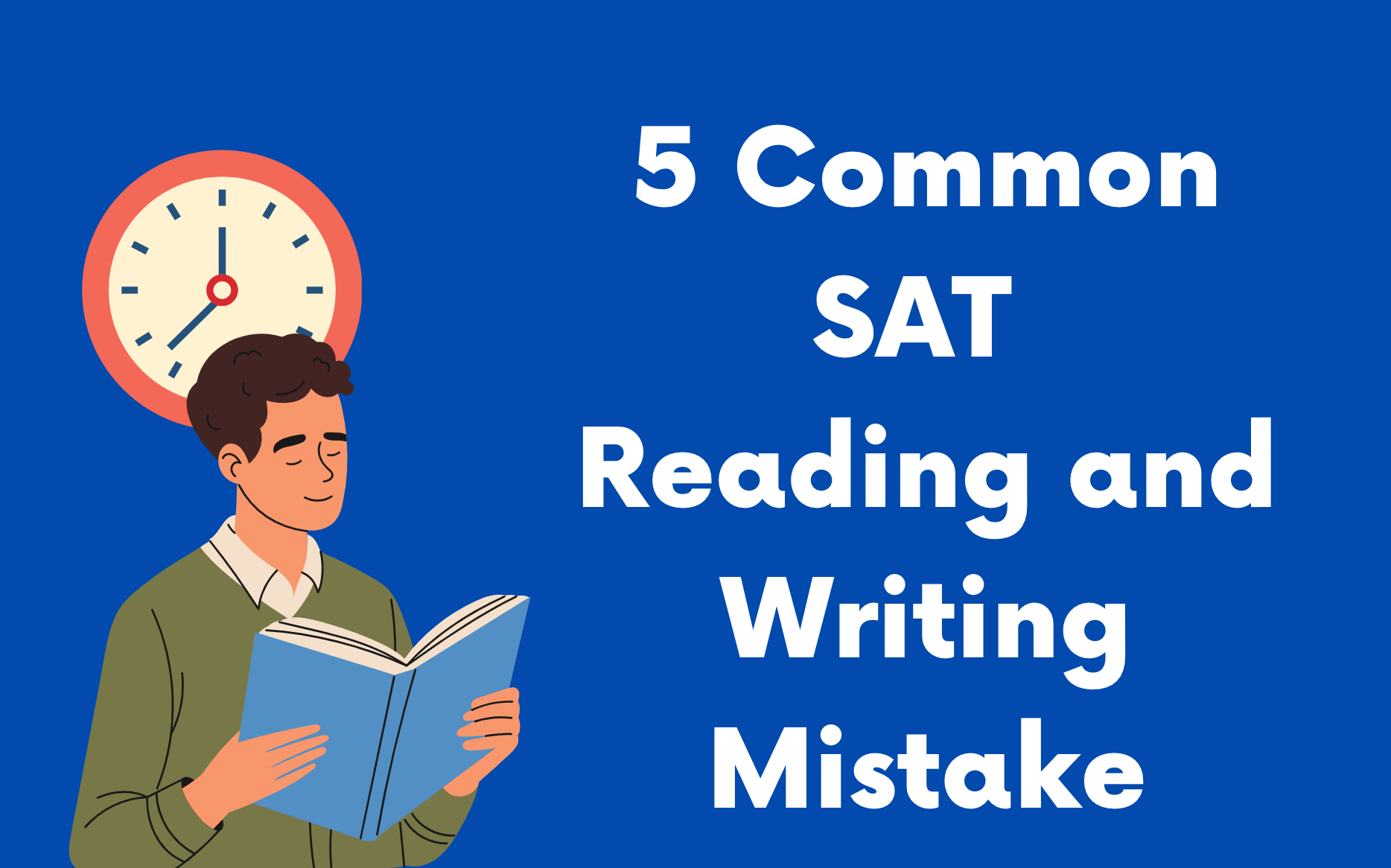
Struggling with the Digital SAT Reading & Writing section? Discover 5 common mistakes students make and actionable tips to boost your score!
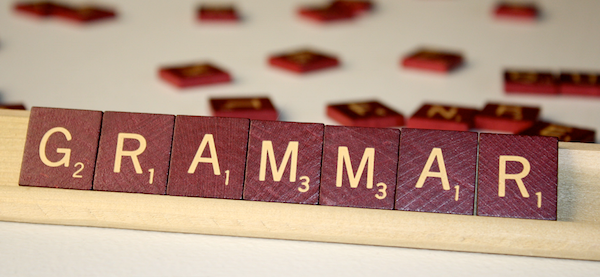
Master the Digital SAT with our comprehensive guide to grammar rules, ensuring you ace the verbal section with confidence.